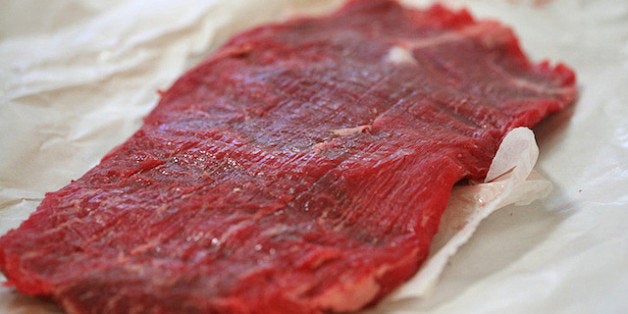
If you keep up with your meat news, you've probably already heard of the merlot cut. The merlot buzzed in the food world a couple of years ago, and while it's still around and selling, we've found that this tender cut hasn't gotten the amount of attention it truly deserves. I hadn't even tried it until this past weekend. But with the first bite, I quickly became a believer. You guys, the merlot steak is delicious, tender and absolutely affordable. In fact, it's my new go-to choice -- and it should probably be yours, too -- and yes, it goes great with a glass of red wine.
While you won't be able to find the merlot at the grocery store, we highly recommend you ask for it at your local butcher. We called on our favorite meat expert, Terry Ragasa from Sutter Meats, to tell us everything we need to know about the merlot. Here's what he had to say:
What exactly is the merlot cut (just to satisfy the food geek in us)?
It is a medial portion of the heel muscle of the meat round. So that is the part that's right above the shank and below the bottom round. The name is gastrocnemius.
How would you describe the merlot to people who aren't familiar with this cut?
I always tell customers when they come in that if they like flank steak they would like the merlot cut because it has the shame shape, the same thickness and it's about the same size. But the merlot has a finer grain than the flank steak so it has a certain tenderness that you can't get from other cuts of the animal.
What's the best way to cook the merlot?
I would treat it just like a flank. It does well with a little tenderizing first, though it doesn't necessarily need it, because it's tender on its own. (But if you're used to eating filet, than the merlot is going to be a little chewier.) It's simple to prepare -- just sear it on either side. (It's a thin cut, so it doesn't require much time.) The merlot is a muscle that actually does some work, so it does better with a little more heat on it. Think: Medium-rare to medium, rather than rare. Like any good steak, you want to let it rest for five minutes before cutting into it. And there is a slight grain to it so you want to cut across the grain.
How did this cut of meat come to be?
I think it has to do with the downturn of the economy. The supermarkets were buying less of the higher end cuts and people were trying to figure out how to get more money off of the animal versus just grinding everything into ground beef.
There's something set up called the Beef Innovations Group that's set out to find these value cuts of the animals and the merlot is one of them. There's also the petite tender, in the shoulder, and the Denver cut, also in the shoulder. They come up with these names, like the merlot, which evoke something. Some of the names, like Denver and the Western Griller, are called that to evoke the range -- people think of being out on a ranch and it makes them want to eat meat. The merlot... maybe it's because it's a finer cut and you want to eat it with some wine.
Which other cuts would you recommend aside from the merlot?
We sell a lot of the Denver cuts, which is the bottom of the chuck eye. And we sell a lot of the ranch steak, a cut that comes from the tricep. That one's even more tender than the merlot cut.